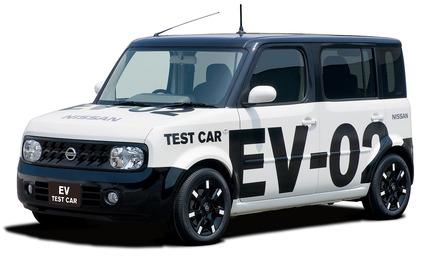 First Drive Review
First Drive Review
When it comes to green cars, the popular play these days is the Hail Mary, a long, high toss down the field for maximum-efficiency yardage and maximum brand polishing. Cost: irrelevant. Production: atomic-level, to hold down inevitable initial losses.
Every automaker has a slightly different attack plan. Toyota has a new and improved Prius coming next year. Honda has a hyperexotic FCX hydrogen fuel-cell car as well as a new Insight, a Prius-fighting hybrid that will appear next year. And GM will unplug its Volt plug-in hybrid in 2010, the same year Nissan plans to debut a pure electric vehicle for the Japanese market with global sales perhaps by 2012.
GM may have killed the electric car, but Nissan plans to defibrillate the corpse with a battery-powered commuter that is cheaper, longer lasting, and more practical. Blandly called the Nissan EV as of this moment, the car’s size, look, price, range, and volume are still secret—or unknown. But Nissan did allow us to briefly sample an 80-kilowatt (107 horsepower) prototype with a 100-mile range at a test track by Tokyo Bay, near Yokohama.
Based on the Japanese-market Nissan Cube [ C/D, October 2008], the EV fits all its electrical gear below the floor. There is no transmission other than a single reduction gear. The EV accelerates with a whisper, rapidly attaining a freeway pace while emitting just the soft whine of goose-stepping electrons. Regenerative braking adds urgency to the stops and helps stretch the range. Engineers are considering some sort of artificial noisemaker to alert pedestrians in Japan’s teeming cities.
This EV prototype weighs 660 pounds more than a stock 2600-pound Cube and looks nothing, we’re told, like the future production EV. The real EV will be longer and lower to better cheat the wind, and have four conventional doors and possibly a hatchback in a body made of both steel and aluminum. According to Nissan design director Shiro Nakamura, as of August the company was still debating whether the car should resemble other Nissans or depart with its own what-Mother-Earth-would-drive motif. We vote for the latter.
These days, battery technology is more vital to automakers than launch codes are to presidents, so the company was somewhat vague about its breakthroughs. The EV’s anticipated 100-mile range depends on advanced lithium-ion batteries from Automotive Energy Supply Corporation, a new joint venture between Nissan and NEC.
To double power density while making the battery box flatter, Nissan uses cells of laminated polymer sheets instead of cylindrical batteries. Heat equals power-sapping resistance, and flat laminated sheets cool better, the company says. “Nanodispersion” technology more evenly disperses microscopic globules of conductive material in the sheets, which also cuts resistance. Careful management of each individual cell ensures the batteries should retain 80 percent of their capacity after seven years or 50,000 miles, which is a more realistic mileage figure for Japanese drivers than for Americans.
Nissan says the production car should exceed 80 kW. No doubt it hopes that the EV’s green halo exceeds measurement.